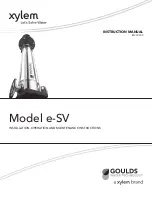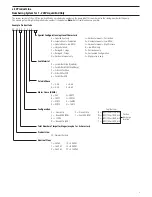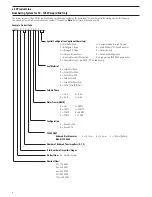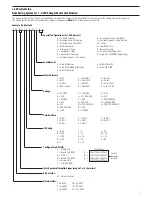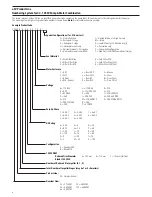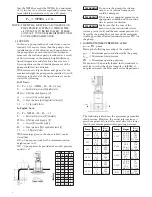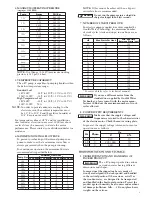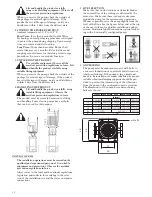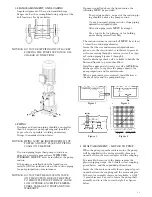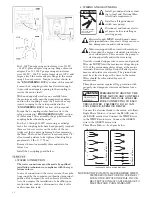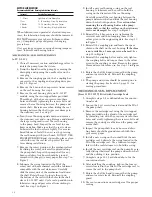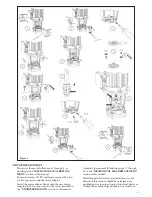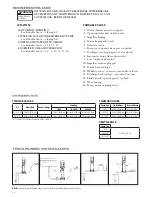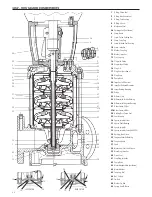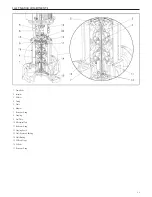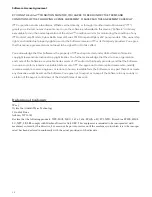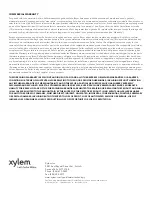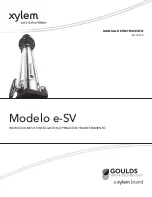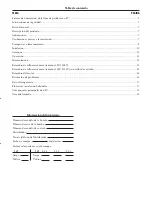
8
that the NPSH
A
exceeds the NPSHr by a minimum
of (2) two feet as a safety margin and to insure long
term reliable performance of your e-SV pump.
NOTE: THE NPSH
A
MUST BE CALCULATED FOR
THE SPECIFIC SYSTEM TO WHICH THE
e-SV PUMP IS TO BE INSTALLED. PLEASE
CONTACT YOUR DEALER/DISTRIBUTOR IF
YOU REQUIRE ASSISTANCE.
2. SUCTION
In theory, a pump could suck water from a source
located 10.33 meters lower than the pump’s own
installation level, but this does not happen because
the pump offers its own intrinsic flow resistance,
moreover the suction capacity is reduced as a result
of flow resistance in the piping, height difference,
liquid temperature and elevation above sea level.
A wrong choice in the altimetric placement of the
pump could lead to cavitation.
With reference to Figure below and given Z as the
maximum height the pump can be installed to, with
reference to the level of the liquid source it can be
stated the following:
In SI Units:
Z = P
b
• 10,2 – NPSH – H
f
- H
v
-0,5 [m]
P
b
=
Barometric pressure [bar] (absolute)
NPSH
r
= NPSH required by pump [m]
H
f
=
Losses [m] in suction piping
H
v
=
Vapor pressure [m] at application temp [C]
1,5
= 1,5 [m] safety factor
In English Units:
Z = P
b
– NPSH
r
– H
f
– H
v
– 1.5
P
b
= Barometric pressure [ft] (absolute)
NPSH
r
= NPSH required by pump [ft]
H
f
= Losses [ft] in suction piping
H
v
= Vapor pressure [ft] at application temp [F]
1.5
= 1.5 [ft] safety factor
With meanings given in the above table it can be
stated that:
If Z
≥
0 pump can work with a maximum suction
height equal to Z.
If Z <0 pump must be provided of an inlet pressure
equal to –Z.
Do not use the pump if cavitation
occurs, as its internal components
could be damaged.
If hot water is pumped, guarantee an
appropriate condition on the suction
side to prevent cavitation.
Make sure that the sum of the
pressure on the suction side (water
system, gravity tank) and the maximum pressure de-
livered by the pump does not exceed the maximum
working pressure allowed (nominal pressure PN) for
the pump.
3. MAXIMUM INLET PRESSURE, 60 HZ
p
1max
≤
PN - pmax
Having the following meaning of the symbols:
p
max
= Maximum pressure delivered by the pump
p
1max
= Maximum inlet pressure
PN = Maximum operating pressure
If a motor with an axially locked shaft (standard) is
used, be sure that the above formula is fulfilled, if
not please contact the Sales and Service Department.
The following table shows the maximum permissible
inlet pressure. However, the actual inlet pr
pressure against a closed valve must always be lower
than the maximum permissible operating pressure.
P
S
MIN
= NPSHr + 2 ft.
Temp
Hv
C F m ft
20 68 0.23 0.75
30 86 0.43 1.41
40 104 0.75 2.46
50 122 1.26 4.13
60 140 2.03 6.66
70 158 3.18 10.43
80 176 4.83 15.84
90 194 7.15 23.45
100 212 10.34 33.92
110 230 14.61 47.92
120 248 20.27 66.49
WARNING
WARNING
WARNING
Pump Stages
P
1max
(psig)
2-5 145
1SV
6-10
218
11-30 PN-Pmax
2-3 145
3SV
4-7
218
8-30 PN-Pmax
2-3 145
5SV
4-6
290
7-27 PN-Pmax
1-2 145
10SV
3-5
290
6-20 PN-Pmax
1-2 145
15SV
3
290
4-15 PN-Pmax
1-2 145
22SV
3
290
4-12 PN-Pmax
Pump Stages
P
1max
(psig)
1/1-2/2 45
33SV
2/1-5/2 145
5/1-7/2 218
7/1-10 PN-Pmax
1/1-1 145
46SV
2/2-2 218
3/2-4/1 290
4-10/2 PN-Pmax
1/1-3/2 72
66SV
3/1-4/1 145
4-5/1 218
5-6 PN-Pmax
1/1-2/2 72
92SV
2/1-3/2 145
3/1-3 218
4/2-5/1 PN-Pmax
125SV
1-3/3B 290
3-5/5A PN-Pmax

